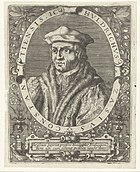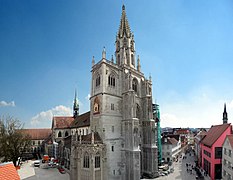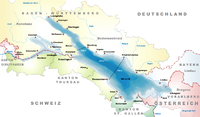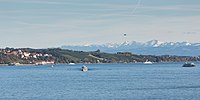Konstanz
|
Constance
Konstanz
|
|
|---|---|

Rheintorturm, a section of the former city wall of Konstanz at
Lake Constance
|
|
|
Location of Constance within Konstanz district

|
|
| Coordinates:47°40′N9°11′E / 47.667°N 9.183°E | |
| Country | Germany |
| State | Baden-Württemberg |
| Admin. region | Freiburg |
| District | Konstanz |
| Subdivisions | 15 |
| Government | |
| •Lord mayor(2020–28) | Ulrich Burchardt[1](CDU) |
| Area | |
| • Total | 55.65 km2(21.49 sq mi) |
| Elevation | 405 m (1,329 ft) |
| Population
(2022-12-31)
[2]
|
|
| • Total | 85,859 |
| • Density | 1,500/km2(4,000/sq mi) |
| Time zone | UTC+01:00(CET) |
| • Summer (DST) | UTC+02:00(CEST) |
| Postal codes |
78462–78467
|
| Dialling codes | 07531, 07533 |
| Vehicle registration | KN |
| Website | www.konstanz.de |
Konstanz(/ˈkɒnstənts/KON-stənts,[3]USalso/ˈkɔːnstɑːnts/KAWN-stahnts,[4][5][6]German:[ˈkɔnʃtants],also[ˈkɔnstants],Alemannic German:[ˈkoʃd̥əts,ˈxoʃd̥əts]), also known asConstancein English, is auniversity citywith approximately 83,000 inhabitants located at the western end ofLake Constancein the south ofGermany. The city houses theUniversity of Konstanzand was the residence of the Roman CatholicDiocese of Konstanzfor more than 1,200 years.
Location
[edit]
The city is located in the state ofBaden-Württembergand situated at the banks of Lake Constance (Bodenseein German). The riverRhine, which starts in theSwiss Alps, passes through Lake Constance and leaves it, considerably larger, by flowing under a bridge connecting the two parts of the city. North of the river lies the larger part of the city with residential areas, industrial estates, and the University of Konstanz; while south of the river is the old town, which houses the administrative centre and shopping facilities in addition to theHochschuleor theUniversity of Applied Sciences. Car ferries provide access across Lake Constance toMeersburg, and theKatamaranprovides a shuttle service for pedestrians toFriedrichshafen. TheGermany–Switzerland borderruns along the southwestern and southern edge of the city, demarcating it from the Swiss town ofKreuzlingen.
Subdivisions
[edit]Konstanz is subdivided into 15 wards or districts (Stadtteile). The island ofMainaubelonged to the ward of Litzelstetten, a separate municipality, until its incorporation into Konstanz on 1 December 1971.

History
[edit]
The first traces of civilization in Konstanz date back to the lateStone Age. During the reign ofAugustus, theCeltsliving south of the Danube were conquered by the Romans. Around 40 AD, the first Romans settled on the site. This small town on the left bank of the Rhine was probably first calledDrusomagusand belonged to theRoman provinceofRaetia. Its later name, originallyConstantia, comes either from the Roman emperorConstantius Chlorus, who fought theAlemanniin the region and built a strong fortress around 300 AD, or from his grandsonConstantius II, who visited the region in 354. The remains of thelate RomanfortressConstantiawere discovered in 2003.
Around 585 the first bishop took up residence in Konstanz and this marked the beginning of the city's importance as a spiritual center. By the lateMiddle Ages, about one quarter of Konstanz's 6,000 inhabitants were exempt from taxation on account of clerical rights.
Trade thrived during the Middle Ages. Konstanz owned the only bridge in the region, which crossed the Rhine, making it a strategic location in theDuchy of Swabia. Itslinenproduction had made an international name for the city and it was prosperous. In 1192, Konstanz gained the status ofImperial Cityso it was henceforth subject only to theHoly Roman Emperor.
In 1414 to 1418, theCouncil of Constancetook place, during which, on 6 July 1415,Jan Hus(Czech religious thinker, philosopher and reformer), who was seen as a threat toChristianityby theRoman Catholic Church, wasburned at the stake. It was here that thePapal Schismwas ended andPope Martin Vwas elected during the onlyconclaveever held north of the Alps.Ulrich von Richental's illustrated chronicle of the Council of Constance testifies to all the major happenings during the council as well as showing the everyday life of medieval Konstanz. TheKonzilgebäudewhere the conclave was held can still be seen standing by the harbour. Close by stands theImperia, a statue that was erected in 1993 to satirically commemorate the council.
In 1460, theSwiss ConfederacyconqueredThurgau, Konstanz's naturalhinterland. Konstanz then made an attempt to get admitted to the Swiss Confederacy, but the forest cantons voted against its entry, fearing overbearing city states; Konstanz then joined theSwabian Leagueinstead. In theSwabian Warof 1499, Konstanz lost its last privileges over Thurgau to the Confederation.
TheProtestant Reformationtook hold in Konstanz in the 1520s, headed byAmbrosius Blarer. Soon the city declared itself officiallyProtestant, pictures were removed from the churches, and the bishop temporarily moved toMeersburg, a small town across the lake. The city first followed theTetrapolitan Confession, and then theAugsburg Confession. However, in 1548 EmperorCharles Vimposed theImperial Banon Konstanz and it had to surrender toHabsburg Austriawhich had suddenly attacked. Thus Konstanz lost its status as an imperial city. The new Habsburg rulers were eager tore-Catholicisethe town and in 1604 aJesuit Collegewas opened. Its accompanying theatre, built in 1610, is the oldest theatre in Germany still performing regularly.
The city became part of theGrand Duchy of Badenin 1806. In 1821, theBishopric of Constancewas dissolved and became part of theArchdiocese of Freiburg. Konstanz became part of theGerman Empirein 1871 during theunification of Germany. AfterWorld War Iit was included within theRepublic of Baden.

On 22 October 1940, 110 of the last Jewish residents were deported toGurs internment campin France. Most of those who were still alive in August 1942 were murdered in eitherSobibórorAuschwitz.
Because it almost lies withinSwitzerland, directly adjacent to the Swiss border, Konstanz was not bombed by theAllied ForcesduringWorld War II. After the war, Konstanz was included first inSouth Badenand then in the new state ofBaden-Württemberg.
TheAltstadt(Old Town), which is large considering the small size of modern Konstanz, has many old buildings and twisting alleys. The city skyline is dominated byKonstanz Cathedral, several other churches and three towers left over from the city wall, one of which marks the place of the former medieval bridge over theRhine.
TheUniversity of Konstanzwas established close to the town in 1966. It houses a library with approximately two million books, all freely accessible 24 hours a day, as well as abotanical garden(theBotanischer Garten der Universität Konstanz). Especially since 2007, the university, being one of the nine German universities most successful in theGerman Universities Excellence Initiative, has gained considerable reputation as a so-called "elite university".
Konstanz was the birthplace of CountFerdinand von Zeppelin, constructor of the famousZeppelinairships. In the late 2010s, Konstanz has become a popular destination forEinkaufstourismus, orcross-border shoppingby Swiss due to lower prices on basic items in Germany, a favorableexchange ratebetween theSwiss francand theeuro, and a generous GermanVATrefund for non-European Unionresidents. Retail chains such asH&Manddmhave built large new stores near the town's central square to cater to this trade, and some Konstanz residents feel the city is losing its historic character in the process; many of them avoid the area on Saturdays. This has led to friction with officials from Kreuzlingen as their city has seen no economic benefit from this trade, and they have been requesting that theirnational governmentbring up the issue of the VAT refund with Germany.[7]Subsequently, Germany has introduced a minimum spend amount of €50.01 per receipt for the German VAT to be refunded. Customs clearance centres are conveniently located near shopping centres.
| Largest groups of foreign residents | |
| Nationality | Population (2014) |
| 1,627 | |
| 1,132 | |
| 568 | |
| 565 | |
| 500 | |
| 381 | |
Climate
[edit]Its location insouth-west Germanygives Konstanz adegraded oceanic climate(Köppen:Cfb) with warm and humid summers (moderated by the lake) as well as cold and snowy winters.
| Climate data for Konstanz (1991–2020 normals, extremes 1961–2021) | |||||||||||||
|---|---|---|---|---|---|---|---|---|---|---|---|---|---|
| Month | Jan | Feb | Mar | Apr | May | Jun | Jul | Aug | Sep | Oct | Nov | Dec | Year |
| Record high °C (°F) | 16.3 (61.3) |
19.4 (66.9) |
24.4 (75.9) |
30.7 (87.3) |
33.1 (91.6) |
36.3 (97.3) |
36.9 (98.4) |
36.5 (97.7) |
30.9 (87.6) |
27.5 (81.5) |
22.0 (71.6) |
17.0 (62.6) |
36.9 (98.4) |
| Mean daily maximum °C (°F) | 3.9 (39.0) |
5.8 (42.4) |
11.1 (52.0) |
16.0 (60.8) |
20.3 (68.5) |
23.9 (75.0) |
25.7 (78.3) |
25.3 (77.5) |
20.3 (68.5) |
14.6 (58.3) |
8.2 (46.8) |
4.5 (40.1) |
15 (59) |
| Daily mean °C (°F) | 1.2 (34.2) |
2.1 (35.8) |
6.0 (42.8) |
10.2 (50.4) |
14.5 (58.1) |
18.1 (64.6) |
19.9 (67.8) |
19.5 (67.1) |
15.0 (59.0) |
10.3 (50.5) |
5.2 (41.4) |
2.0 (35.6) |
10.3 (50.5) |
| Mean daily minimum °C (°F) | −1.0 (30.2) |
−0.9 (30.4) |
2.0 (35.6) |
5.2 (41.4) |
9.5 (49.1) |
13.2 (55.8) |
15.0 (59.0) |
14.8 (58.6) |
11.1 (52.0) |
7.3 (45.1) |
2.9 (37.2) |
−0.1 (31.8) |
6.6 (43.9) |
| Record low °C (°F) | −21.8 (−7.2) |
−21.5 (−6.7) |
−17.5 (0.5) |
−6.2 (20.8) |
−4.4 (24.1) |
0.2 (32.4) |
3.7 (38.7) |
4.0 (39.2) |
−0.5 (31.1) |
−4.0 (24.8) |
−9.5 (14.9) |
−14.0 (6.8) |
−21.8 (−7.2) |
| Averageprecipitationmm (inches) | 45.8 (1.80) |
44.8 (1.76) |
50.6 (1.99) |
56.5 (2.22) |
89.2 (3.51) |
99.7 (3.93) |
96.3 (3.79) |
97.7 (3.85) |
69.4 (2.73) |
62.8 (2.47) |
57.5 (2.26) |
63.2 (2.49) |
833.7 (32.82) |
| Average precipitation days(≥ 1.0 mm) | 14.1 | 12.8 | 14.1 | 13.1 | 15.0 | 15.5 | 15.2 | 14.8 | 13.3 | 14.0 | 14.2 | 15.8 | 171.9 |
| Average snowy days(≥ 1.0 cm) | 7.0 | 7.2 | 2.1 | 0.2 | 0 | 0 | 0 | 0 | 0 | 0.1 | 1.7 | 5.3 | 23.6 |
| Averagerelative humidity(%) | 85.9 | 80.8 | 73.8 | 68.8 | 70.3 | 70.2 | 70.1 | 73.5 | 79.7 | 85.5 | 87.6 | 87.6 | 77.8 |
| Mean monthlysunshine hours | 49.1 | 75.4 | 129.8 | 205.2 | 239.7 | 239.6 | 234.2 | 214.4 | 161.5 | 116.0 | 52.0 | 37.7 | 1,824.1 |
| Source 1:NCEI,[8](extremes for the 1961-1990 period[9]) | |||||||||||||
| Source 2: Data derived fromDeutscher Wetterdienst[10] | |||||||||||||
| Climate data for Konstanz, 2015-2020 normals | |||||||||||||
|---|---|---|---|---|---|---|---|---|---|---|---|---|---|
| Month | Jan | Feb | Mar | Apr | May | Jun | Jul | Aug | Sep | Oct | Nov | Dec | Year |
| Mean daily maximum °C (°F) | 4.3 (39.7) |
5.8 (42.4) |
11.8 (53.2) |
16.7 (62.1) |
20.1 (68.2) |
25.5 (77.9) |
27.5 (81.5) |
26.7 (80.1) |
21.3 (70.3) |
15.4 (59.7) |
9.1 (48.4) |
5.4 (41.7) |
15.8 (60.4) |
| Mean daily minimum °C (°F) | −0.1 (31.8) |
0.0 (32.0) |
2.7 (36.9) |
6.0 (42.8) |
10.0 (50.0) |
14.7 (58.5) |
16.5 (61.7) |
16.0 (60.8) |
11.9 (53.4) |
8.0 (46.4) |
4.2 (39.6) |
1.2 (34.2) |
7.6 (45.7) |
| Averageprecipitationmm (inches) | 57.2 (2.25) |
37.5 (1.48) |
38.3 (1.51) |
60.6 (2.39) |
99.2 (3.91) |
85.1 (3.35) |
74.1 (2.92) |
89.1 (3.51) |
44.2 (1.74) |
52.2 (2.06) |
47.1 (1.85) |
30.4 (1.20) |
714.9 (28.15) |
| Average precipitation days(≥ 1.0 mm) | 9.5 | 8.5 | 10.7 | 10.4 | 11.3 | 11.9 | 11.5 | 10.8 | 9.5 | 9.1 | 9.7 | 10.7 | 123.6 |
| Averagerelative humidity(%) | 84 | 80 | 75 | 72 | 73 | 74 | 74 | 77 | 81 | 85 | 86 | 85 | 79 |
| Mean monthlysunshine hours | 54 | 83 | 157 | 207 | 208 | 252 | 280 | 246 | 189 | 121 | 60 | 53 | 1,910 |
| Source 1:DWD[11]andMeteoSchweiz(unavailable) | |||||||||||||
| Source 2: weather-online[12] | |||||||||||||
| Climate data for Konstanz (Mainau Forest), elevation: 447 m, 1961-1990 normals and extremes | |||||||||||||
|---|---|---|---|---|---|---|---|---|---|---|---|---|---|
| Month | Jan | Feb | Mar | Apr | May | Jun | Jul | Aug | Sep | Oct | Nov | Dec | Year |
| Record high °C (°F) | 14.2 (57.6) |
17.4 (63.3) |
24.4 (75.9) |
28.0 (82.4) |
33.1 (91.6) |
33.7 (92.7) |
36.0 (96.8) |
33.5 (92.3) |
30.5 (86.9) |
27.5 (81.5) |
22.0 (71.6) |
17.0 (62.6) |
36.0 (96.8) |
| Mean daily maximum °C (°F) | 2.4 (36.3) |
4.6 (40.3) |
9.5 (49.1) |
14.0 (57.2) |
18.6 (65.5) |
21.8 (71.2) |
24.1 (75.4) |
23.3 (73.9) |
20.1 (68.2) |
13.8 (56.8) |
7.2 (45.0) |
3.3 (37.9) |
13.6 (56.4) |
| Daily mean °C (°F) | 0.0 (32.0) |
1.3 (34.3) |
4.7 (40.5) |
8.7 (47.7) |
13.1 (55.6) |
16.3 (61.3) |
18.5 (65.3) |
17.7 (63.9) |
14.7 (58.5) |
9.7 (49.5) |
4.3 (39.7) |
1.0 (33.8) |
9.2 (48.5) |
| Mean daily minimum °C (°F) | −2.2 (28.0) |
−1.4 (29.5) |
1.1 (34.0) |
4.2 (39.6) |
8.2 (46.8) |
11.6 (52.9) |
13.6 (56.5) |
13.4 (56.1) |
10.7 (51.3) |
6.8 (44.2) |
2.0 (35.6) |
−1.0 (30.2) |
5.6 (42.1) |
| Record low °C (°F) | −21.8 (−7.2) |
−21.5 (−6.7) |
−17.5 (0.5) |
−6.2 (20.8) |
−4.4 (24.1) |
0.2 (32.4) |
3.7 (38.7) |
4.0 (39.2) |
−0.5 (31.1) |
−4.0 (24.8) |
−9.5 (14.9) |
−14.0 (6.8) |
−21.8 (−7.2) |
| Averageprecipitationmm (inches) | 52.0 (2.05) |
51.0 (2.01) |
51.0 (2.01) |
68.0 (2.68) |
85.0 (3.35) |
105.0 (4.13) |
102.0 (4.02) |
88.0 (3.46) |
71.0 (2.80) |
54.0 (2.13) |
65.0 (2.56) |
57.0 (2.24) |
849 (33.44) |
| Average precipitation days(≥ 1.0 mm) | 10.0 | 9.0 | 10.0 | 11.0 | 13.0 | 12.0 | 12.0 | 12.0 | 8.0 | 8.0 | 10.0 | 10.0 | 125 |
| Mean monthlysunshine hours | 43.0 | 73.4 | 124.9 | 161.7 | 198.6 | 218.1 | 244.6 | 215.3 | 171.1 | 99.8 | 52.6 | 37.0 | 1,640.1 |
| Source:NOAA[9] | |||||||||||||
Main sights
[edit]- Archaeological Museum
- Imperia, a 9 m-tall sculpture
- Jan Hus Museum
- Konstanz Cathedral
- Konziledifice, dating to the 15th century
- Niederburg (Lower Castle)
- Petershausen Abbey
- Remains of a Roman fortress, near the Cathedral
- Schnetztor, fortified gate of the former city walls
Konstanz was also home to a largesynagogue, destroyed by theNazigovernment in 1938.
Twin towns – sister cities
[edit] Fontainebleau, France (1960)
Fontainebleau, France (1960) Richmond upon Thames, England, United Kingdom (1983)
Richmond upon Thames, England, United Kingdom (1983) Tábor, Czech Republic (1984)
Tábor, Czech Republic (1984) Lodi, Italy (1986)
Lodi, Italy (1986) Suzhou, China (2007)
Suzhou, China (2007)
Transport
[edit]Konstanz stationis the eastern terminus of theHigh Rhine Railwayline, running westwards toSingen, with connections to all parts of Germany and theSwisscities ofSchaffhausenandBasel. There are three other stations in Konstanz along this line:Konstanz-Fürstenberg,Konstanz-PetershausenandKonstanz-Wollmatingen. In addition, Konstanz station is linked via two connectors (in both directions) to theLake Line, which runs along the Swiss shore of Lake Constance and theHigh Rhine. It is indirectly also linked to theWil–Kreuzlingen railwayline toWeinfelden, with connections to long-distance trains in Switzerland. Services are provided by theDeutsche Bahn AGand also theSwiss Federal Railwaysand its subsidiariesThurboandSBB GmbH.
The nearestairportis atFriedrichshafen, which can be reached by a fastferryservice on the lake, which also connects Konstanz to other lakeside towns. The airport mainly hosts domestic flights, but flights toAustriaandTurkeyare available. The nearest international airports are inStuttgart, inBasel, andZurich, which has a direct train from Konstanz. Bus services within the city are provided byStadtwerke KonstanzGmbH.
Additionally Konstanz andFriedrichshafenhave been connected by the two (since 2008, three)catamaransConstanceandFridolinsince 2005.
World Heritage Site
[edit]It is home to one or more prehistoricpile-dwelling(or stilt house) settlements that are part of thePrehistoric Pile dwellings around the AlpsUNESCO World Heritage Site.[14]
Notable people
[edit]Public service and commerce
[edit]

- Ulrich Zasius(1461–1536), jurist[15]
- Ernst Vögelin(1529–1589), pioneer book printer
- Wacker von Wackenfels(1550–1619), diplomat, scholar and author
- Johann Friedrich Cotta(1764–1832) a publisher, industrial pioneer and politician; in 1825 he started steamboats on Lake Constance.[16]
- Johann Leonhard Hug(1765–1846) a Catholic theologian, orientalist and biblical scholar.[17]
- Guillaume Henri Dufour(1787–1875) a Swiss military officer, structural engineer and topographer.[18]
- CountFerdinand von Zeppelin(1838–1917), a German general and inventor of theZeppelinrigid airships.[19]
- Josef Albert Amann(junior) (1866–1919), gynecologist
- Conrad Grober(1872–1948), priest and archbishop, teacher and pastor in Konstanz
- Friedrich Flick(1883–1972), entrepreneur and convicted Nazi war criminal
- Michaela von Neipperg(1885–1957), countess and Benedictine nun, religious superior at the Municipal Women's Clinic Konstanz
- Siegfried Adolf Handloser(1885–1954), doctor of the German Armed Forces Medical Services
- Melanie Risch(1887–1944), victim of Nazism
- Werner Berger(1901–1964), SS-Oberscharführer and member of commando 99 in Buchenwald concentration camp
- Julius Federer(1911–1984), jurist
- Egon Mayer(1917–1944), fighter ace in theLuftwaffeduringWorld War II
- Werner Maihofer(1918–2009), politician (FDP), member of Bundestag, minister of the interior (1974–1978)
- Theo Sommer(1930–2022), newspaper editor atDie Zeitsince 1958, rising to editor-in-chief and publisher
- Rolf Böhme(1934–2019), Staatssekretär (1978–1982), mayor of Freiburg (1982–2002)
- Horst Frank(b. 1949), jurist, Lord Mayor of Konstanz 1996–2012
- Ian Murdock(1973–2015), American software engineer, founder of theDebianproject
- Larissa Vassilian(born 1976), German-Armenian journalist

The arts
[edit]- Tobias Pock(1609–1683), Austrian Baroque painter of Swabian descent, a pioneer of sacral art
- Marie Ellenrieder(1791–1863), painter
- Jacob Picard(1883–1967), writer
- Anne Winterer(1894–1938), photographer
- François Stahly(1911–2006), French sculptor
- Hans Maria Wingler(1920–1984), art historian and founder of Bauhaus-Archive
- Rosemarie Banholzer(born 1925), dialect author
- Berthold Keller(1927–2012), trade unionist
- Martin Gotthard Schneider(1930–2017), church musician, songwriter and theologian
- Uli Trepte(1941–2009), musician
- Carola Zwick(born 1966), product designer
Gallery
[edit]-
The late Roman fortress Constantiaat the Münsterplatz
-
The Konzilgebäudein Konstanz
-
Konstanz Marktstätte, the main square in the old town
See also
[edit]- Alexander-von-Humboldt-Gymnasium
- Cathedral of Konstanz
- Hochschule Konstanz(University of Applied Sciences)
- University of Konstanz
- Tägermoos
Notes
[edit]References
[edit]- ^Aktuelle Wahlergebnisse, Staatsanzeiger, accessed 13 September 2021.
- ^"Bevölkerung nach Nationalität und Geschlecht am 31. Dezember 2022"[Population by nationality and sex as of December 31, 2022](CSV)(in German).Statistisches Landesamt Baden-Württemberg. June 2023.
- ^Wells, John C.(2008).Longman Pronunciation Dictionary(3rd ed.). Longman.ISBN978-1-4058-8118-0.
- ^"Konstanz".The American Heritage Dictionary of the English Language(5th ed.). HarperCollins. Retrieved21 July2019.
- ^"Konstanz".Collins English Dictionary.HarperCollins. Retrieved21 July2019.
- ^"Constance".Merriam-Webster.com Dictionary. Merriam-Webster. Retrieved21 July2019.
- ^Gagnon, Milan (March 6, 2017)."The Swiss Invasion".Slate. RetrievedMarch 6,2017.
- ^"World Meteorological Organization Climate Normals for 1991–2020: Konstanz".World Meteorological Organization Climatological Standard Normals (1991–2020). National Oceanic and Atmospheric Administration. Archived fromthe originalon 12 October 2023. Retrieved12 October2023.
- ^ab"Konstanz (10929) - WMO Weather Station".NOAA. RetrievedFebruary 5,2019.
- ^"Wetter und Klima - Deutscher Wetterdienst - CDC (Climate Data Center)".www.dwd.de.
- ^"Ausgabe der Klimadaten: Monatswerte".
- ^"Kostanz (442m)".weatheronline.co.nz.
- ^"Städtepartnerschaften".konstanz.de(in German). Konstanz. Retrieved2021-02-16.
- ^Centre, UNESCO World Heritage."Prehistoric Pile Dwellings around the Alps".whc.unesco.org.
- ^.Catholic Encyclopedia. Vol. 15. 1912.
- ^.Encyclopædia Britannica. Vol. 7 (11th ed.). 1911. pp. 250–251, page 251.
his youngest son, Johann Friedrich, Freiherr Cotta von Cottendorf (1764–1832).... In 1825 he started steamboats, for the first time, on Lake Constance, and introduced them in the following year on the Rhine.
- ^.Encyclopædia Britannica. Vol. 13 (11th ed.). 1911. p. 856.
- ^.Encyclopædia Britannica. Vol. 8 (11th ed.). 1911. p. 646.
- ^.Encyclopædia Britannica. Vol. 32 (12th ed.). 1922. p. 1128.
External links
[edit]- Coolidge, William Augustus Brevoort(1911)..Encyclopædia Britannica. Vol. 6 (11th ed.). pp. 984–985.
- Official website
- (in German)Konstanz: history and images at "alemannische-seiten.de"
- University of Konstanz
- Pictures Konstanz
- Online journal about Constance
- University of Applied Sciences
- Photos of the Carnival (~Shrovetide, ~Mardi Grass) in Constance
- Südkurier(Südkurier) Local newspaper for Konstanz












